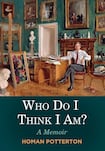
You can tell this book by its cover. The painting reproduced on the cover of Homan Potterton's new memoir, Who Do I Think I Am?, depicts his life story at its climax, the full fruition of his metamorphosis from shy Co Meath farm boy to the supremo of Ireland's art establishment. Here is his svelte person draped languorously on a chair in the office of the director of the National Gallery of Ireland. Surrounded by some of his favourite, most valuable oils, he is triumphant, yet his face is composed in the inscrutable expressionlessness of a shrewd poker player. He wanted his directorship recoded, but not as a formal "boardroom portrait", so he commissioned Andrew Festing. A one-time president of the Royal Society of Portrait Painters, to portray him in a casually elegant "conversation piece", which seems also to answer the book's interrogative title.
Potterton was proud enough of his antecedents to research their genealogy all the way back to their 17th-century English roots, and published a detail account of it, Potterton People and Places: Three Centuries of an Irish Family. However, in his widely praised first memoir, Rathcormick, named after the ancient home farm, he expressed inherited diffidence.
“I am the 10th generation of my family, almost in a direct line, to have lived at Rathcormick,” he writes. “But what is so remarkable is that the family has remained so ordinary, so . . . undistinguished. Modesty has always governed our ambitions, plainness has been the salient feature of our demeanour. . .”
The youngest of eight children (two girls, six boys), Homan was only 14 years of age when his father died, but paternal intolerance evidently had already crushed the boy’s self-esteem. In spite of the relief of a summer holiday at 16 in a congenial French ménage, he went to Trinity College Dublin still handicapped by a sense of inferiority. He confesses now that he opened a supposedly confidential letter of introduction to Trinity from the headmaster of his Dublin boarding school, and read: “He has a colourless personality, and he is unlikely to contribute anything to the university.”
“I do not think I had ‘a colourless personality’ when I went up to Trinity,” he writes. “But I certainly developed one when I was there. The college in those days could be a very intimidating place, socially rather than academically. . .” He told himself: “If I survive the social intimidation of Trinity, nothing or no one will intimidate me socially ever again.” He was fortified by an inner core of ambition very much like steel. The rest of the book is devoted implicitly to the reconstruction, enlargement and coloration of his ego, a task which, as his many friends and rivals would probably agree, he has concluded brilliantly. He gained respectable credentials in his undergraduate studies of art history at Trinity and went on for a further degree in that esoteric subject at Edinburgh University, with sufficient distinction to get a job, eventually, in 1974, against energetic competition, as an assistant keeper at the National Gallery in London.
After six years that he describes as “the time of my life”, in and outside the gallery, he was so much in demand that he was able to play hard to get, but finally succumbed to the blandishments of James White, the director of the National Gallery of Ireland, to succeed him on his retirement. In 1980, Homan, at the age of 33, was the youngest man ever to achieve that status.
The day his appointment was ratified he took shelter in a Dublin pub and was appalled by its squalor. But quite soon afterwards, though dependent at first on the kindness of strangers, he found that his bachelorhood, astuteness and adaptability made it apparent that he was a natural genius of public relations and an indefatigable guest, able to infiltrate all those elements of Irish society, from Desmond Guinness (whom he admired) to the taoiseach, Charles Haughey (whom he deplored), who were able to benefit the gallery and himself.
Two long excerpts from his 1973 Dublin diaries provide enlightening gossip, which will surely provide refreshment for readers, as it must have provided for the author, tiring of accounts of institutional administration. Potterton’s keen observation of grand domestic architecture, decor and furniture and individuals’ costumes, hair-styles and jewelry, which he terms bijouterie, must have added zest to his conversation. The companions whose company he enjoyed most included one “extraordinarily called Speer Ogle”, an affluent art connoisseur and mentor. “Over the ensuing years,” Homan recalls, “the notes requesting assignations which peer left for me at my rooms became more frequent and our friendship – which was always Platonic – deepened.”
Potterton’s own special artistic expertise was in Venetian painting of the 17th and 18th centuries; however, his legacy is a survey of all great classic art. He left illustrated catalogues of the gallery’s entire collections of oil paintings, watercolours, drawings and miniatures , the first such catalogues ever collated since the gallery was first opened to the public in 1864. His other principal achievements were convincing the board that it was worth spending a lot of money to acquire fine paintings of proved authenticity. He also persuaded Sir Alfred and Lady Beit to donate their important collection of paintings to the gallery, and, in a risky operation worthy of a novel by Raymond Chandler, helped the Garda retrieve the paintings when they were stolen.
Surprisingly, after only eight years in the directorship, Potterton resigned, mainly because of refusal of his repeated requests for repair of the “dilapidated and dangerous building”. There were “constant union negotiations”, he adds, “staff dissatisfaction, government cuts and more cuts, my salary taxed at 67 per cent. . .” Literary royalties fortunately enabled him to retire at the age of 42, and he lives in rural France.











